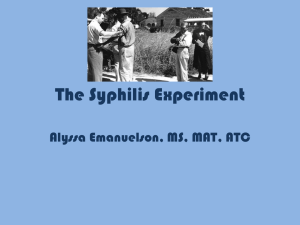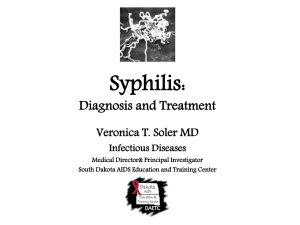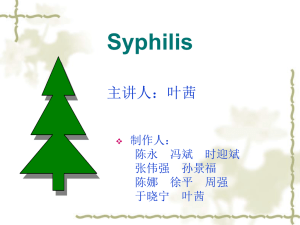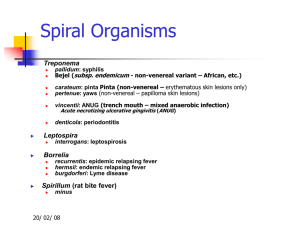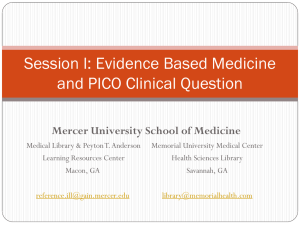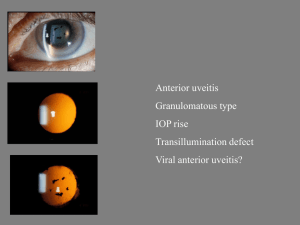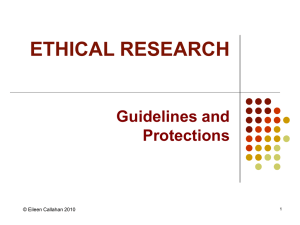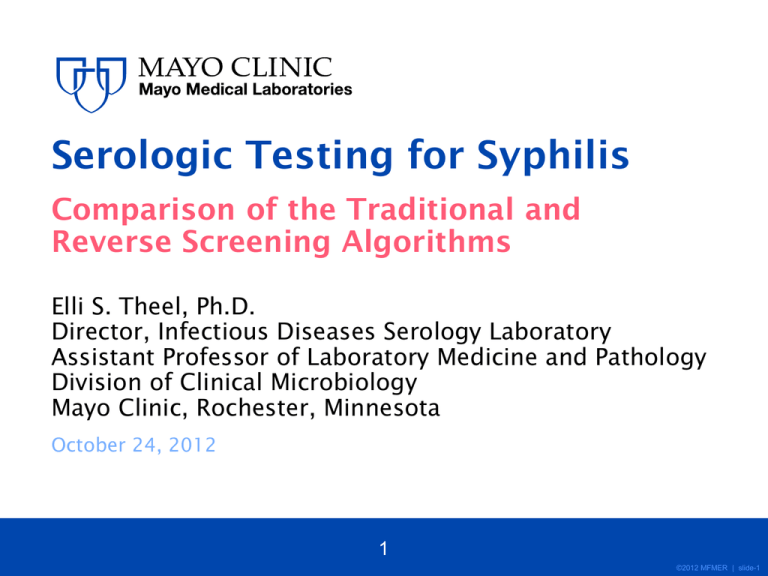
Serologic Testing for Syphilis
Comparison of the Traditional and
Reverse Screening Algorithms
Elli S. Theel, Ph.D.
Director, Infectious Diseases Serology Laboratory
Assistant Professor of Laboratory Medicine and Pathology
Division of Clinical Microbiology
Mayo Clinic, Rochester, Minnesota
October 24, 2012
1
©2012 MFMER | slide-1
Disclosures
None
2
©2012 MFMER | slide-2
Objectives
• Describe the treponemal and non-treponemal
assays for syphilis screening
• Discuss the advantages and limitations of both the
traditional and reverse syphilis screening
algorithms
• Result interpretation from the reverse syphilis
screening algorithm
3
©2012 MFMER | slide-3
Outline
• Syphilis Infection
• Causative Agent
• Clinical Manifestations
• Laboratory Tests for Diagnosis of Syphilis
• Non-treponemal Tests
• Treponemal Tests
• Traditional Algorithm for Syphilis Screening
• Reverse Algorithm for Syphilis Screening
• Interpretation and Follow-up
4
©2012 MFMER | slide-4
Treponema pallidum – The Agent of Syphilis
• Spirochete
• Obligate human parasite
• Transmission
• Sexual
wadsworth.org
• Trans-placental
• Percutaneous following contact with infectious
lesions
• Blood Transfusion
• No reported cases of transmission since 1964
5
©2012 MFMER | slide-5
Syphilis – The “Great Imitator”
• Infectious Dose: ~57 organisms1
• Incubation Period – 21 days (median)
• 3 clinical stages of syphilis
• Primary:
• Painless sore (chancre) at inoculation site
• Secondary:
• Rash, Fever, Lymphadenopathy, Malaise
• Tertiary/Latent:
• CNS invasion, organ damage
• “The physician that knows syphilis knows medicine.”
– Sir William Osler
1Magnuson
HJ, et al. Inoculation of syphilis in human volunteers. Medicine 1956;35:33-82
http://www.cdc.gov/std/syphilis/stdfact-syphilis.htm
6
©2012 MFMER | slide-6
Laboratory Diagnosis of Syphilis
http://www.els.net
The Uncommon Methods
• Rabbit Infectivity Test (RIT)
• High Sensitivity and Specificity
• Long turn-around-time
• Limited to research settings
• Dark Field Microscopy
• Useful only during primary infection
• Technician expertise required
• Immunostaining
CDC/NCHSTP/Dividion of STD Prevention
• Direct fluorescent antibody or silver stain
• Polymerase Chain Reaction (PCR)
• Not commercial available
textbookofbacteriology.net
7
©2012 MFMER | slide-7
Laboratory Diagnosis of Syphilis
The Common Methods
• Serology
• Mainstay for syphilis testing
• Two classes of serologic tests
• Non-treponemal
• Treponemal
8
©2012 MFMER | slide-8
Serologic Tests for Syphilis:
Non-Treponemal Assays
• Principle:
• T. pallidum infection leads to the production of
reagin
• Reagin – Antibodies to substances released from
cells damaged by T. pallidum
• Reagin reacts with cardiolipin
• Cardiolipin – a phospholipid component of certain
eukaryotic and prokaryotic membranes
• Examples of non-treponemal tests:
• Rapid Plasma Reagin (RPR)
• Venereal Disease Research Laboratory (VDRL)
9
©2012 MFMER | slide-9
Serologic Tests for Syphilis:
Non-Treponemal Assays
• RPR and VDRL are agglutination assays
Charcoal
Cardiolipin
10
©2012 MFMER | slide-10
Serologic Tests for Syphilis:
Non-Treponemal Assays
• RPR and VDRL are agglutination assays
Charcoal
Cardiolipin
Reagin
Serum
or
CSF
11
©2012 MFMER | slide-11
Non-Treponemal Tests:
Advantages
• Rapid turnaround time – Minutes
• Inexpensive
• No specialized instrumentation required
• Usually revert to negative following therapy
• Can be used to monitor response to therapy
12
©2012 MFMER | slide-12
Non-Treponemal Tests:
Limitations
• Results are subjective
• Intra- and Inter-laboratory variability
• Non-specific
• False positive results can result from other
infectious or non-infectious conditions
• EBV, Lupus, etc.
• Limited sensitivity in early/primary syphilis and in
late/latent syphilis
• Low throughput
• Problematic for high volume laboratories
13
©2012 MFMER | slide-13
Non-Treponemal Tests:
Limitations, continued
• Possibility for prozone effect
• High levels of antibody may inhibit the
agglutination reaction
• To identify prozone, labs must serially dilute
samples
Undilute
1:2
1:4
1:8
1:16
14
©2012 MFMER | slide-14
Serologic Tests for Syphilis:
Treponemal Assays
• Principle:
• Infection leads to production of specific antibodies
directed against T. pallidum
• Treponemal tests detect IgG or total IgM/IgG
antibodies directed against T. pallidum
15
©2012 MFMER | slide-15
Serologic Tests for Syphilis:
Treponemal Assays
• Microhemagglutination assay (MHA)
• Fluorescent treponemal antibody (FTA-ABS)
• Treponema pallidum particle agglutination (TP-PA)
• Enzyme Immunoassay (EIA)
• Multiplex Flow Immunoassay (MFI)
FTA-ABS
TP-PA
Conventional EIA
www.mastgrp.biz
Yellow wells = positive
16
©2012 MFMER | slide-16
Treponemal Assays:
Multiplex Flow Immunoassays
Syphilis IgM
Syphilis IgG
Patient
Serum
Added
17
©2012 MFMER | slide-17
Treponemal Assays:
Multiplex Flow Immunoassays
Syphilis IgM
Labeled anti-IgM and
anti-IgG reporter
antibody added
Syphilis IgG
Patient
Serum
Added
18
©2012 MFMER | slide-18
Treponemal Assays:
Multiplex Flow Immunoassays
Syphilis IgM
Labeled anti-IgM and
anti-IgG reporter
antibody added
Syphilis IgG
Patient
Serum
Added
Laser 1 identifies the bead
(IgM vs. IgG)
Laser 2 determines if the
target antibody is present
(presence or absence of fluor)
Bound beads are passed
through the laser detector
19
©2012 MFMER | slide-19
Treponemal Assays:
Advantages
• High Specificity
• Possibly higher sensitivity during early and late
syphilis stages compared to non-treponemal tests
• Newer Methods
• Objective result interpretation
• Automation option
• High throughput
• High reproducibility/precision
20
©2012 MFMER | slide-20
Treponemal Assays:
Limitations
• Remain positive despite treatment
• Cannot be used to monitor response to therapy
• Conventional Methods
• Subjective interpretation requiring technician
expertise to read
• Newer Methods
• Expensive instrumentation
• Higher cost/test
21
©2012 MFMER | slide-21
Syphilis Screening Algorithms:
Traditional versus Reverse Screening
22
©2012 MFMER | slide-22
Traditional Algorithm
Non-treponemal test (e.g., RPR)
Reactive
Non-reactive
Treponemal test (e.g., FTA)
Reactive
Syphilis
Negative for syphilis
Non-reactive
Negative for syphilis
23
©2012 MFMER | slide-23
Traditional Algorithm
Non-treponemal test (e.g., RPR)
Reactive
Non-reactive
Treponemal test (e.g., FTA)
Reactive
Syphilis
Negative for syphilis
Non-reactive
Negative for syphilis
Advantages:
•
•
•
•
Results show good correlation with disease status
Rapid, inexpensive screening method
Excellent option for laboratory with small throughput
Recommended by the CDC
24
©2012 MFMER | slide-24
Traditional Algorithm
Non-treponemal test (e.g., RPR)
Reactive
Non-reactive
Treponemal test (e.g., FTA)
Reactive
Syphilis
Negative for syphilis
Non-reactive
Negative for syphilis
Disadvantages:
• Manual (RPR) and subjective interpretation
• Screening method is non-specific and may lead to falsepositive results
• Not suitable for high throughput laboratories
• Potentially lower sensitivity for detecting early syphilis and
late/latent disease
25
©2012 MFMER | slide-25
The Traditional Syphilis Algorithm:
If it works, why change it?
Cases (in thousands)
• Incidence of disease impacts the positive predictive value of
the assay
Primary and secondary
Early latent
Total syphilis
Year
Rate per 100,000
population
0.2
0.21-2.2
>2.2
http://www.cdc.gov/std/stats09/figures/33.htm
26
©2012 MFMER | slide-26
Reverse Algorithm
Treponemal test (eg, EIA)
Reactive
Non-reactive
Non-Treponemal test (eg, RPR)
Reactive
Syphilis
Negative for syphilis
Non-reactive
Second Treponemal Test (e.g., TP-PA)
Reactive
Non-reactive
Evaluation Required*
Negative for syphilis
27
©2012 MFMER | slide-27
Reverse Algorithm:
Advantages
• Automated treponemal screening assays are available (i.e.,
EIA, MFI)2
• > 500 sera/9 hr shift by MFI vs. ~ 200 sera/9 hr shift by
manual methods
• Objective interpretation of results
• Results from EIA or MFI can be interfaced with LIS
• Specific screening test for anti-T. pallidum antibodies
• Potentially increased detection of patients with early
syphilis3:
• Among 560 patients with lesions, 18 (3.2%) were EIA (+), DFA
(+) and RPR (-)
• Among 9,137 patients with EIA (+), RPR (-) results, 54 became
RPR (+) on follow-up testing
28
©2012 MFMER | slide-28
Reverse Algorithm:
Limitations
• Higher cost/sample
• Higher assay complexity
• Increased detection of patients with screen (+), RPR (-)
results4,5:
• CDC - ~56% of EIA reactive samples are non-reactive by
RPR
• How do we interpret these results?
29
©2012 MFMER | slide-29
Reverse Syphilis Screening Algorithm:
Result Interpretation
Case #1
• 37-year-old with HIV
• Presents to primary care physician with a 2-week
history of fatigue, intermittent fever and new rash on
palms and soles
• Previously resolved genital lesion
• Syphilis serology ordered
• Syphilis IgG by EIA: positive
• RPR: positive, titer of 1:64
30
©2012 MFMER | slide-30
Reverse Syphilis Screening Algorithm:
Result Interpretation
Case #1 Conclusion
• No further testing needed on this sample
• Interpretation: “Untreated or recently treated
syphilis.” Follow CDC treatment guidelines4
• For treatment follow-up:
• Samples can be tested directly by RPR.
• A 4-fold decrease in RPR titers (eg, 1:64 to
1:16) is interpreted as response to therapy
31
©2012 MFMER | slide-31
Reverse Syphilis Screening Algorithm:
Result Interpretation
Case #2
• 23-year-old female
• Evaluated during first-trimester, routine pregnancy
visit
• Previously healthy
• Syphilis serology ordered
• Syphilis IgG by EIA: positive
• RPR: negative
• Second treponemal test, TP-PA: negative
32
©2012 MFMER | slide-32
Reverse Syphilis Screening Algorithm:
Result Interpretation
Case #2 Conclusion
• Interpretation: “Probable false-positive screening test.
Negative for syphilis.”
• False-positive serologic tests are not uncommon
during pregnancy and confirmatory testing is often
required
• Syphilis IgM testing not recommended for routine
pregnancy screening
33
©2012 MFMER | slide-33
Reverse Syphilis Screening Algorithm:
Result Interpretation
Case #3
• 50-year-old immigrant from Somalia
• Pre-kidney transplant evaluation
• Syphilis serology ordered
• Syphilis IgG by EIA: positive
• RPR: negative
• TP-PA: positive
34
©2012 MFMER | slide-34
Reverse Syphilis Screening Algorithm:
Result Interpretation
Case #3 Conclusion
• Interpretation: “Historical and clinical evaluation
required.”
• During evaluation with provider, patient indicates no
known history of treatment for syphilis.
• Patient treated for possible latent syphilis
35
©2012 MFMER | slide-35
Reverse Syphilis Screening Algorithm:
Result Interpretation
Case #4
• 30-year-old inmate
• Past history of syphilis (10 years prior)
• Syphilis serology ordered
• Syphilis IgG by EIA: positive
• RPR: negative
• Interpretation: “Past, successfully treated
syphilis. No further testing for syphilis
required.”
36
©2012 MFMER | slide-36
Reverse Syphilis Screening Algorithm:
Summary
Patient history
Unknown history
of syphilis
Unknown history
of syphilis
Unknown history
of syphilis
Unknown history
of syphilis
Known history of
syphilis
Treponemal
screen
NEG
POS
POS
POS
POS
RPR
2nd
treponemala Interpretation
NA
POS
NEG
NEG
NEG
Follow-up
NA
No serologic
evidence of
syphilis
None, unless
clinically indicated
(eg, early syphilis)
NA
Untreated or
recently treated
syphilis
See CDC
treatment
guidelines; follow
RPR titers
NEG
Probable falsepositive
screening test
No follow-up
testing, unless
clinically indicated
POS
Possible syphilis
History and
(eg, latent) or
clinical evaluation
previously
required
treated syphilis
Past,
POS or NA successfully
treated syphilis
None
aSecond
treponemal test should be TP-PA or a different method than screening test
For CDC treatment guidelines see http://www.cdc.gov/std/treatment/default.htm
37
©2012 MFMER | slide-37
Reverse Syphilis Screening Algorithm:
Summary
Patient history
Unknown history
of syphilis
Unknown history
of syphilis
Unknown history
of syphilis
Unknown history
of syphilis
Known history of
syphilis
Treponemal
screen
NEG
POS
POS
POS
POS
RPR
2nd
treponemala Interpretation
NA
POS
NEG
NEG
NEG
Follow-up
NA
No serologic
evidence of
syphilis
None, unless
clinically indicated
(eg, early syphilis)
NA
Untreated or
recently treated
syphilis
See CDC
treatment
guidelines; follow
RPR titers
NEG
Probable falsepositive
screening test
No follow-up
testing, unless
clinically indicated
POS
Possible syphilis
History and
(eg, latent) or
clinical evaluation
previously
required
treated syphilis
Past,
POS or NA successfully
treated syphilis
None
aSecond
treponemal test should be TP-PA or a different method than screening test
For CDC treatment guidelines see http://www.cdc.gov/std/treatment/default.htm
38
©2012 MFMER | slide-38
Reverse Syphilis Screening Algorithm:
Summary
Patient history
Unknown history
of syphilis
Unknown history
of syphilis
Unknown history
of syphilis
Unknown history
of syphilis
Known history of
syphilis
Treponemal
screen
NEG
POS
POS
POS
POS
RPR
2nd
treponemala Interpretation
NA
POS
NEG
NEG
NEG
Follow-up
NA
No serologic
evidence of
syphilis
None, unless
clinically indicated
(eg, early syphilis)
NA
Untreated or
recently treated
syphilis
See CDC
treatment
guidelines; follow
RPR titers
NEG
Probable falsepositive
screening test
No follow-up
testing, unless
clinically indicated
POS
Possible syphilis
History and
(eg, latent) or
clinical evaluation
previously
required
treated syphilis
Past,
POS or NA successfully
treated syphilis
None
aSecond
treponemal test should be TP-PA or a different method than screening test
For CDC treatment guidelines see http://www.cdc.gov/std/treatment/default.htm
39
©2012 MFMER | slide-39
Reverse Syphilis Screening Algorithm:
Summary
Patient history
Unknown history
of syphilis
Unknown history
of syphilis
Unknown history
of syphilis
Unknown history
of syphilis
Known history of
syphilis
Treponemal
screen
NEG
POS
POS
POS
POS
RPR
2nd
treponemala Interpretation
NA
POS
NEG
NEG
NEG
Follow-up
NA
No serologic
evidence of
syphilis
None, unless
clinically indicated
(eg, early syphilis)
NA
Untreated or
recently treated
syphilis
See CDC
treatment
guidelines; follow
RPR titers
NEG
Probable falsepositive
screening test
No follow-up
testing, unless
clinically indicated
POS
Possible syphilis
History and
(eg, latent) or
clinical evaluation
previously
required
treated syphilis
Past,
POS or NA successfully
treated syphilis
None
aSecond
treponemal test should be TP-PA or a different method than screening test
For CDC treatment guidelines see http://www.cdc.gov/std/treatment/default.htm
40
©2012 MFMER | slide-40
Reverse Syphilis Screening Algorithm:
Summary
Patient history
Unknown history
of syphilis
Unknown history
of syphilis
Unknown history
of syphilis
Unknown history
of syphilis
Known history of
syphilis
Treponemal
screen
NEG
POS
POS
POS
POS
RPR
2nd
treponemala Interpretation
NA
POS
NEG
NEG
NEG
Follow-up
NA
No serologic
evidence of
syphilis
None, unless
clinically indicated
(eg, early syphilis)
NA
Untreated or
recently treated
syphilis
See CDC
treatment
guidelines; follow
RPR titers
NEG
Probable falsepositive
screening test
No follow-up
testing, unless
clinically indicated
POS
Possible syphilis
History and
(eg, latent) or
clinical evaluation
previously
required
treated syphilis
Past,
POS or NA successfully
treated syphilis
None
aSecond
treponemal test should be TP-PA or a different method than screening test
For CDC treatment guidelines see http://www.cdc.gov/std/treatment/default.htm
41
©2012 MFMER | slide-41
Conclusions
• Syphilis is typically diagnosed by serologic means
• Two main classes of syphilis serologic tests:
• Non-treponemal (e.g., RPR, VDRL)
• Treponemal (e.g., FTA, TP-PA, EIA, MFI)
• Traditional Algorithm
• Non-treponemal test first
• Screen by RPR
• If RPR positive use treponemal test to confirm
• Advantages
• Recommended by CDC
• Cost-effective
• Suitable for most lower throughput labs
• Limitations
• May miss very early or late/latent infection
42
©2012 MFMER | slide-42
Conclusions
• Reverse Algorithm
• Treponemal test first
• Screen by EIA or MFI
• Screen positive samples tested by nontreponemal test: RPR
• EIA/MFI and RPR discordant samples should be
tested by a second treponemal test: TP-PA
• Advantages
• Allows for automation and increased sample
throughput
• Limitations
• Result interpretation can be challenging
• Good communication with providers is critical
43
©2012 MFMER | slide-43
References
1
Magnuson HJ, et al. Inoculation of syphilis in human volunteers.
Medicine (Baltimore) 1956;35:33-82.
2
Binnicker MJ, et al. Treponema-specific test for serodiagnosis of
syphilis: comparative evaluation of seven assays. J Clin Microbiol
2012;49:1313-1317
3
Mishra S, et al. The laboratory impact of changing syphilis
screening from the rapid-plasma reagin to a treponemal enzyme
immunoassay: a case study from the greater Toronto area. Sex
Transm Dis 2011; 38:190-196
4
CDC. Discordant results from reverse sequence syphils screening:
five laboratories, United States, 2006-2010. Morb Mortal Wkly
Rep 2011;60:133-137
5
Binnicker MJ, et al. Direct comparison of the traditional and
reverse syphilis screening alorithms in a population with a low
prevalence for syphilis. J Clin Microbiol 2012; 50:148-150
44
©2012 MFMER | slide-44
Questions & Discussion
45
©2012 MFMER | slide-45

